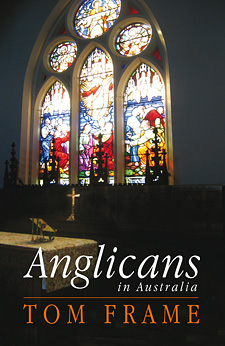Tom Frame wrote this book because he thought five books written between 2002-2006 neither helped "greater understanding" of the Anglican Church nor helped the conversation between groups that differ within the Church. After critiquing the deficiencies in these other works " fearless Tom, fearless! - Frame's goal in this book is "to describe contemporary Australian Anglicanism".
To understand the framework of the author it is well to know that Tom Frame is a Bishop describing himself as a "Consensus Anglican": one who cherishes the Reformed and Catholic characteristics of the Anglican tradition. He wants the Anglican Church in Australia to succeed as a national church and, indeed, with a united voice to the Australian community. Indeed he gets cranky with those of his brother bishops who sledge others in the church. But isn't sledging part and parcel of the Australian way?!
 On the basis that the past defines the present, Part One of the book is historical. Frame explains how the Anglican Church's identity comes from its English legacy and then its transported form in Australia. This is the strongest part of the book: the identity issues embedded in that past are causal in the character of the Church today. Frame rightly points out that the Church in England's theology "was eminently practical because it was frequently a servant of ecclesiology". Frame describes this as a problem of "an Established Church" which has fundamental links with the State. However he seems to pull back from seeing it as a problem of a ""comprehensive" Church. My question is that if our understanding of Christ drives and defines our sense of mission, should that not then determine how we order and organise ourselves and, if that is so, is not the Anglican Church as a national institution upside down and back the front? Is that not then the fundamental flaw?
On the basis that the past defines the present, Part One of the book is historical. Frame explains how the Anglican Church's identity comes from its English legacy and then its transported form in Australia. This is the strongest part of the book: the identity issues embedded in that past are causal in the character of the Church today. Frame rightly points out that the Church in England's theology "was eminently practical because it was frequently a servant of ecclesiology". Frame describes this as a problem of "an Established Church" which has fundamental links with the State. However he seems to pull back from seeing it as a problem of a ""comprehensive" Church. My question is that if our understanding of Christ drives and defines our sense of mission, should that not then determine how we order and organise ourselves and, if that is so, is not the Anglican Church as a national institution upside down and back the front? Is that not then the fundamental flaw?
In Part Two of the book Frame proposes that there are three Crises for the Church: a crisis in Believing (fewer believers) had consequences for both Belonging and Behaving. The generalisations made in this part, primarily drawn from aggregated surveys, are less satisfactory: many Sydney Anglicans will be surprised to learn that "traditional worship" and "sharing the Eucharist" is what they most value. Given that Frame notes the huge differences in different parts of the Australian Church, this would have been a stronger section if he had divined where the Church was strongest in belief and where there was growth in belonging - and why.
Part Three recognises that the lack of a national identity is a continuing challenge and Frame is clearly frustrated that other Anglicans don't share his concern for this. His strongest point in this final section is when he notes the importance of Anglicans participating in public debate on Australian social issues. Here, there are enormous opportunities: social issues in Australia are almost always about the means but not the ends of human existence. On the latter, there is a vacuum which Anglicans must responsibly fill.
For those who want to understand more about Anglicans in Australia, this book is worth reading. Is Frame's book a work of history? Well, no, it is not a definitive history of the Anglican Church, although a good third of the book is historical. Is the book a work of sociology? Well, no, but a third of it does contain a form of sociology that is derivative in form. Is it a series of essays, some of which are Episcopal opinion pieces? Yes, I think it is and if you approach the book thinking of it as a series of associated essays you will not be disappointed.
Dr Stephen Judd is Chief Executive of Hammond Care, an independent Christian charity. While still very young, he co-authored in 1987 Sydney Anglicans: A History of the Diocese.
















